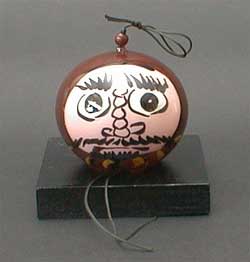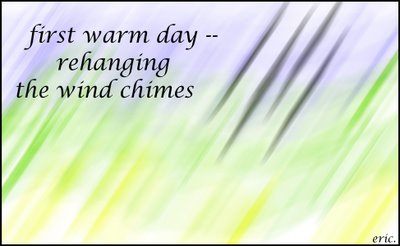:::::::::::::::::::::::::::::::::::::::::::::::::::::::::::::::::::::::::::::::::::::::::::::::::::::
Wind Chimes (fuurin, Japan)
***** Location: Japan
***** Season: All Summer
***** Category: Humanity
*****************************
Explanation
fuurin 風鈴 (ふうりん) wind chime
fuurin uri 風鈴売(ふうりんうり) vendor of wind chimes

. . . CLICK here for Photos !
..........................................

tsuri shinobu 釣忍 (つりしのぶ)
wind chimes hanging from a plant arrangement
..... 夏 釣荵(つりしのぶ)、吊荵(つりしのぶ)
noki shinobu 軒しのぶ(のきしのぶ)
wind chimes hanging from the eaves
. . . . . but
plant kigo for all autumn
some saijiki place "shinobu 忍" in "all summer"
shinobugusa 忍草 (しのぶぐさ)
weeping fern, hare's foot fern
grass of longing remembrance, fern of longing
...... itsumadegusa, itsumade kusa 何時迄草(いつまでぐさ)
..... nokishinobu 軒しのぶ(のきしのぶ)
Lepisorus thunbergianus. Pakahakaha in Hawaii
御廟年経て忍は何をしのぶ草
gobyoo toshi hete shinobu wa nani o shinobu-gusa
The imperial tomb has stood
for ages; what do you recall,
fern of longing?
Tr. Barnhill
Matsuo Basho in Yoshino, at the Temple Nyoirin-ji
Nozarashi Kiko
time passes by the mausoleum
and what is there to remember -
weeping fern
Tr. Gabi Greve
. Matsuo Basho in Yoshino .

source : itoyo/basho
The mausoleum for Godaigo Tenno 後醍醐帝御廟
Emperor Go-Daigo (後醍醐天皇 Go-Daigo-tennō)
(November 26, 1288 – September 19, 1339)
© More in the WIKIPEDIA !
. . . CLICK here for Photos !
. Matsuo Basho 松尾芭蕉 - Archives of the WKD .
:::::::::::::::::::::::::::::::::::::::::::::::::::::::::::::::::::::::::::::::::::::::::::::::::::::
plant kigo for all winter
kareshinobu, kare shinobu 枯忍 (かれしのぶ)
withered weeping fern
kan shinobu 寒忍 (かんしのぶ) weeping fern in the cold
fuyu shinobu 冬忍(ふゆしのぶ)weeping fern in winter
tachi shinobu 立忍(たちしのぶ) "standing weeping fern"
Onychium japonicum
. . . CLICK here for Photos !
.................................................................................
Please read Part 1 of the kigo story here:
. Wind Chimes ... Introduction .

http://www.sam.hi-ho.ne.jp/maruyosi/daruma.htm
*****************************
Worldwide use
windchimes
There is an ongoing discussion as to the wind chimes and their seasonal reference.
Soji from USA:
My own experience, in my part of the country, says that "windchime" could be a spring or summer kigo. In the spring we start opening the windows for the fresh, unconditioned breeze to freshen stale winter rooms.
And, though the windows may get opened when the heat of summer is upon us, when the heat and humidity simultaneously hit 90ー and 90%, respectively, the windows will go down, the air conditioning come on, and the melodious sounds of the windchimes are locked out, only marginally appreciated by some intrepid, but foolhardy, traveler, or the postal delivery person.
ooo ooo ooo ooo ooo ooo ooo ooo
Kala Ramesh from India:
'windchimes' should be considered a spring chime....
In India the breeze gets beautiful again .... in North India the Winter months can be freezing - then with spring the windows are opened ....
the nights all over India in spring gets cool and fresh - with the smell of mango blossoms and the fragrance of flowers like the jasmine and paarijat.
yes - windchimes - is a spring kigo as far as India is concerned.
India in summer can be unbearable - who wants that hot breeze - even if they chime our bells?!!
ooo ooo ooo ooo ooo ooo ooo ooo
Linda Papanicolaou from USA:
Spring is when there's a breeze to stir the windchime.
Summer weather is often hot and still, and my windchime rings seldom.
ooo ooo ooo ooo ooo ooo ooo ooo
Bill Higginson, USA:
The rationale behind season words is tradition, not personal or local experience.
It makes sense to add certain items to a season word list according to local custom, such as holidays, unique cultural features, and particular weather phenomena or creature-behaviors unique to a specific region, provided they are included at times when poets have in fact noticed them and writen about them. But this is not always the case for phenomena of more or less universal experience.
Wind chimes (note: two words) have been around a lot longer than air conditioners, and will probably outlast the latter by several millennia.
In the haiku tradition, which is a fairly well-established tradition of some 5-700 years, wind chimes have long been associated with summer. And while I do not need to deny modern experience such as those confined to city or uncommonly hot climates being aware of outdoor surroundings mainly in spring and autumn, the fact is that wind chimes are associated not with the high winds of spring, but with the pleasant breezes of summer, bringing a bit of cooling relief.
Thus, their deeply summerish meaning is underscored. The very essence of wind chimes is the coolness we feel in that breeze.
A haiku on the subject of wind chimes must almost of necessity bring out a sense of coolness, whether a breeze is mentioned or not (and the word "cool" need not, indeed, should not be mentioned, but suggested).
There are phenomena that span more than one season, in which case, like frogs and moon, there are special times of the year when our consciousness of them peaks, so they represent those seasons (spring and autumn, respectively).
Or, like "butterfly", the simple word by itself is assigned to one season (spring), and there are other, amplified phrases that designate the same or similar phenomenon in other seasons, viz. "summer butterfly", "autumn butterfly", "freezing butterfly" (winter).
Thus, any phenomenon can be fit into any season, if the writer has the need to make it so. But not so with any season word!
(There are also words that designate more than one phenomenon, and are not well handled in some Japanese saijiki and dictionaries only confuse the matter, such as _kagerou_, which can mean "heat waves" or "shimmering heat" [spring] and "gossamer" or "floating strands of spider web" [autumn]. This is a very complex instance, and there are a few others similarly so.)
And the even larger question:
The overriding factor here is that, unless one is in a very distinctly different climatic zone than mid-temperate central Japan, on which the Japanese saijiki is nominally based, and the phenomenon in question is already recorded in a common Japanese saijiki, then *millions of poets* already relate to it that way.
Why would anyone in a country with a handful of haiku poets think they should go off in some other direction? (Exceptions: tropics, such as Taiwan, Hawaii, Central America; South Asia; etc., where distinctly different seasons from those in the temperate zone prevail.)
Ultimately, the majority of poets from a relatively consistent climatic zone worldwide should prevail. And there are more Japanese already there, in terms of the mid-temperate zone, with literally millions upon millions of haiku already in place based on a fairly consistent and useful understanding of the seasons (which many of them falsely maintain is "so unique to Japan"), why would anyone want to "push the river"?
Go with the flow of what is already in place, as far as saijiki placement is concerned, and you can't go seriously wrong.
As to writing our haiku, we do well to write from experience. But getting our backs up over season word conventions and placement in a saijiki is not a good exercise in creativity!

© Haiku and Haiga by Eric Houck Jr.
Bill Higginson about this Haiga:
The season word of this poem is "first warm day", which is a specific turn on the spring topic "warm", and the wind chime is not a seasonal element in the poem. If anything, this poem confirms the summer seasonality of "wind chime", by the very mention of that first warm day.
A good haiku, and not in the least controversial, as far as seasonal understanding is concerned.
Please note:
The inclusion of what would otherwise be a season word for season X in a poem clearly of season Y means that the seasonal quality of the x-word is trumped, as far as the y-poem is concerned. Or, as in this case, the seasonality of the y-poem is actually enhanced by the presence of the season-X word, which helps establish the "cuspishness" of the phenomenon as observed.
*****************************
Things found on the way
Daruma san and the wind chimes
. . . DARUMA and Wind Chimes
PHOTO ALBUM : Wind Chimes
*****************************
HAIKU
A poem from an old friend
the sound of wind chime,
where will the wind carry this song?
Kio
http://groups.yahoo.com/group/searchingfortheox/message/721
xxxxxxxxxxxxxxxxxxxxxxxxxxxxx
my little wind chimes -
your sound is heared
all over the world
Gabi Greve,
with respect to the above discussion, March 2006
*****************************
Related words
. Wind Chimes ... Introduction .
[ . BACK to DARUMA MUSEUM TOP . ]
[ . BACK to WORLDKIGO . TOP . ]
::::::::::::::::::::::::::::::::::::::::::::::::::::::::::::::::::::::::::::::::::::::::::::::::::::::








5 comments:
making music
with a bamboo chime--
lake breeze
roh mih, Philippines
http://haiku.cc.ehime-u.ac.jp/nobo/20061025/18471.html
.
Wind in various kigo
(kaze, Japan)
.
.
the clinking sound
is drifting
on the city’s smog ...
© Danny C. Sillada, Manila
Look at Danny's beautiful paintings HERE !
::::::::::::::::::::::::::::::::::::::::::::::::::::::::::::::::::::::
しのぶさへ枯て餅かふやどり哉
shinobu sae karete mochi kau yadori kana
even the fern of longing
is withered; buying rice-cakes
at an inn
Matsuo Basho
Tr. Barnhill
This hokku has the cut marker KANA at the end of line 3.
even the shinobu fern has withered
and I buy mochi ricecakes
at the inn . . .
Tr. Gabi Greve
Matsuo Basho
橋桁の忍は月の名残り哉
hashigeta no shinobu wa tsuki no nagori kana
Written on the 13th day of the 9th lunar month 1691.
Post a Comment